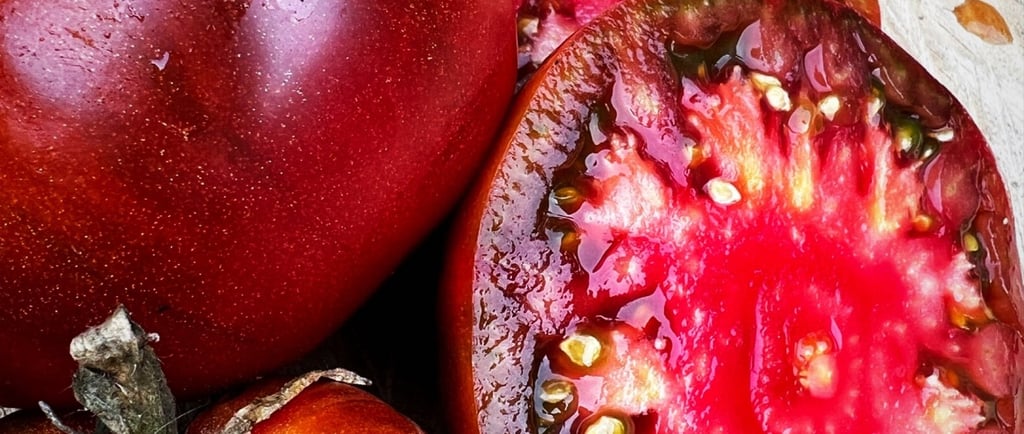FREE UK P&P ON ORDERS £20+
DEFRA LICENSED - 100% HEIRLOOM, OPEN-POLLINATED, SMALL BATCH, HIGH QUALITY SEEDS

Easy Tomato Growing Guide
Start Growing Your Own Tomatoes in 2024, find out why I love heirlooms.
1/25/20243 min read


It’s no secret that I love growing tomatoes, with so many varieties to choose from (the list is quite literally endless), along with the kaleidoscope of colours not to mention the shapes, sizes but above all flavour. You simply cannot beat the flavour bursting out of ripe, warmed by the sun home grown tomatoes.
Personally, heirloom varieties are my go to as opposed to hybrids, for several reasons. The seeds have been selected over many years for certain traits, size, colour, shape, and taste. Hybrid varieties are mostly bred to have a high yield, good storage, and disease resistance to name a few, however this also comes at the expense of flavour.
Heirloom tomatoes breed true, so if you save seeds, the plant that you grow will be like the parent plant that you saved the seeds from. Hybrid seeds don’t always breed true, if you saved seeds to grow on you could end up with a plant that resembles another plant entirely.
Tomato plants can be grown either outdoors or indoors, you don’t need a vast amount of space, they don’t have to be planted in the ground, larger pots and hanging baskets will suffice; due to the varieties on offer you’re sure to find one or more that suit your growing area.
Seeds can be sown from the end of February to mid/late March if you’ll be growing in a heated greenhouse or indoors at home, even earlier if you have specific equipment such as a grow tent and lights.
Seeds can take anything from 5-10 days to germinate if given optimal conditions. If there’s not enough heat and/or light the seedlings will become ‘legggy’, however this easily remedied when potting on by burying the stem a little deeper.
Young, well-rooted plants grown from seed indoors should be ready to plant into their final position in early summer I usually start planting mine out in June depending on the weather and once all danger of frost is passed.
Prior to planting out they do need to be ‘hardened off’ you can do this by putting them in a cold frame, or like me by placing them outdoors during the day in a warm spot and bringing them in at night for roughly a week, after that they can be left outside in a warm, sheltered spot during the day and night.
Bush/Determinate varieties are fabulous for large patio containers, troughs, window boxes and even hanging baskets. These varieties are shorter and have a ‘bush’ growth habit as the name suggests. These are easier to grow and require less maintenance and support aside from watering and feeding. The side shoots shouldn’t be removed.
Cordon/Indeterminate types grow well in large containers and require supports as they can grow up to 1.8m (6’) tall, great for growing in a greenhouse or outdoors in a sunny sheltered position. Great if space is limited as they grow tall, and don’t ‘bush’ if you pinch out the side shoots (suckers).They’re slightly more maintenance as they’ll require you to tie them in to their supports, however with the correct watering and feeding they produce a heavy crop.
Watering and feeding your plants are key for a fabulous crop. Plants should be watered regularly to keep the soil/compost moist. Over or under watering can cause issues with the fruit such as splitting or blossom end rot. Plants in containers may need watering every day in hot weather.
To aid pollination especially if you’re growing plants in a greenhouse, polytunnel etc open the door and windows/vents to let in pollinators you can also gently tap or shake the flowers to help pollen transfer in the flower. To increase fruiting, feed plants every 10-14 days once the first fruits start to set.
Then all you must do is wait patiently for the fruits to ripen from mid-summer onwards, cherry varieties will usually ripen first.
Wishing you all a fantastic 2024 tomato growing year!
